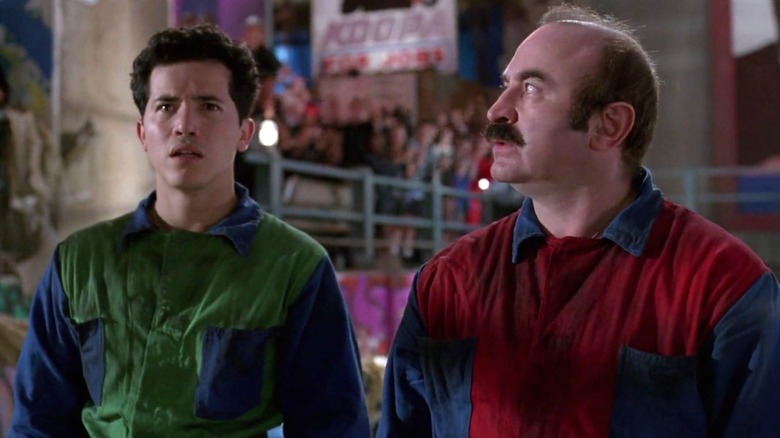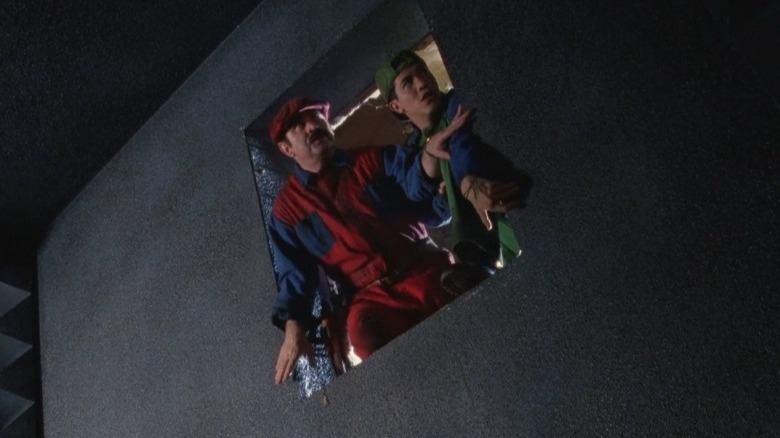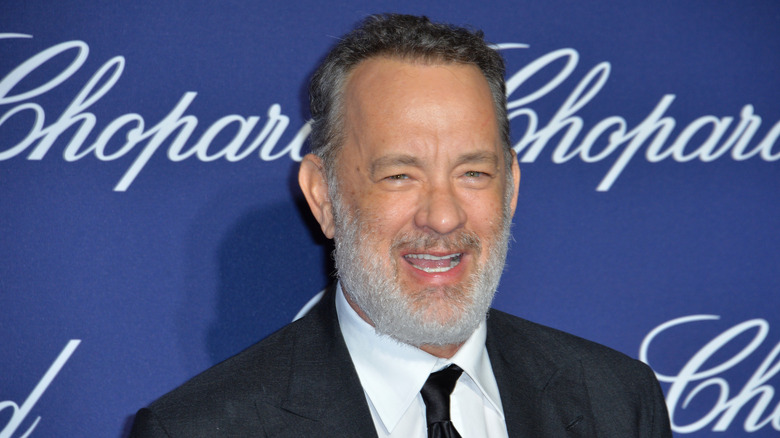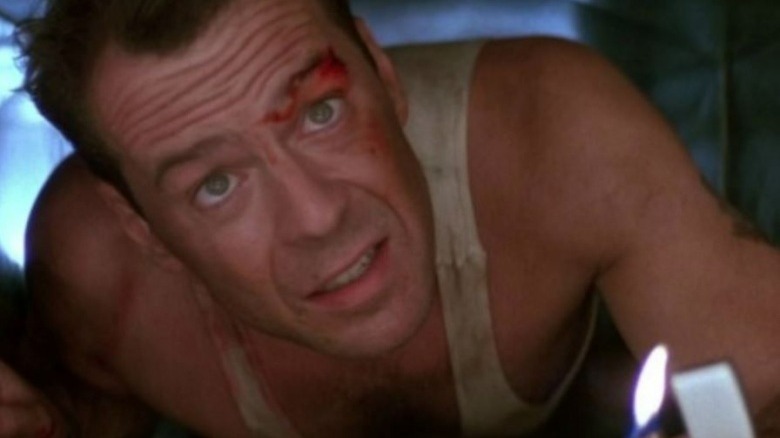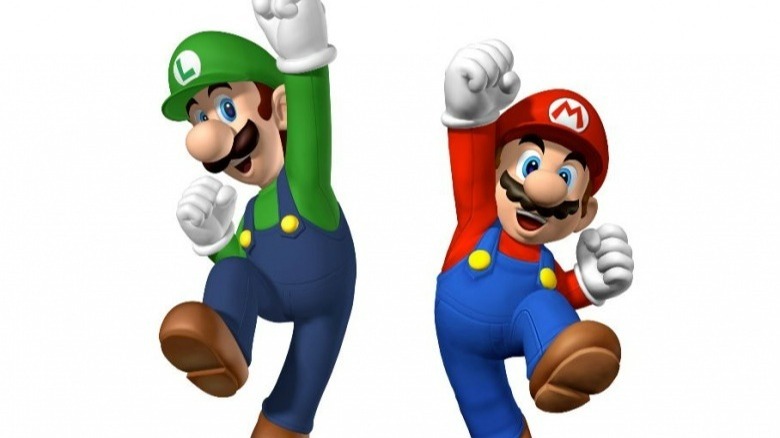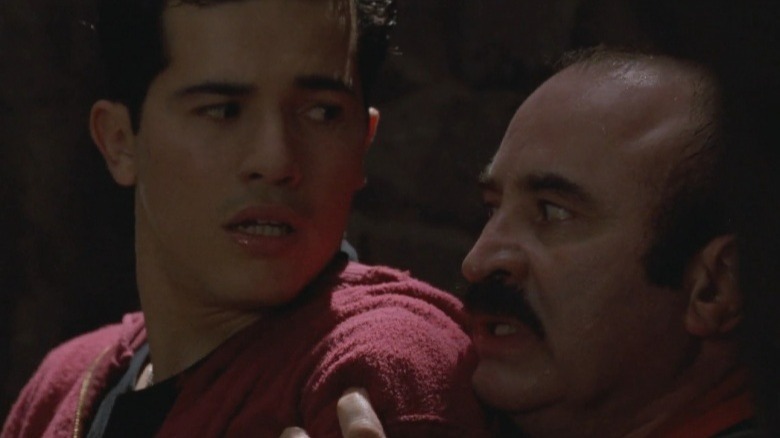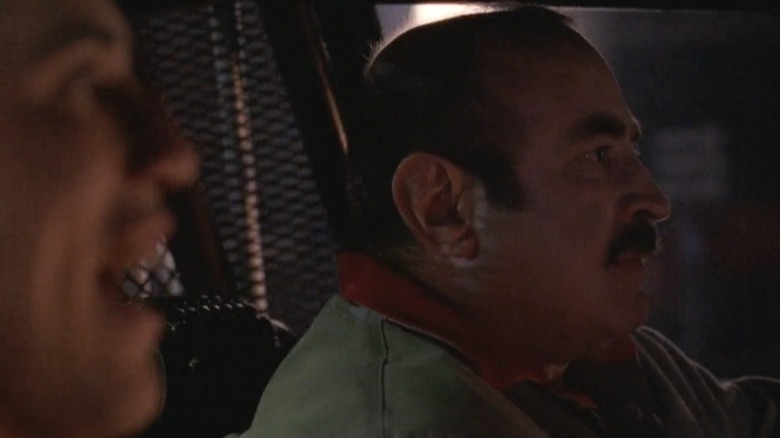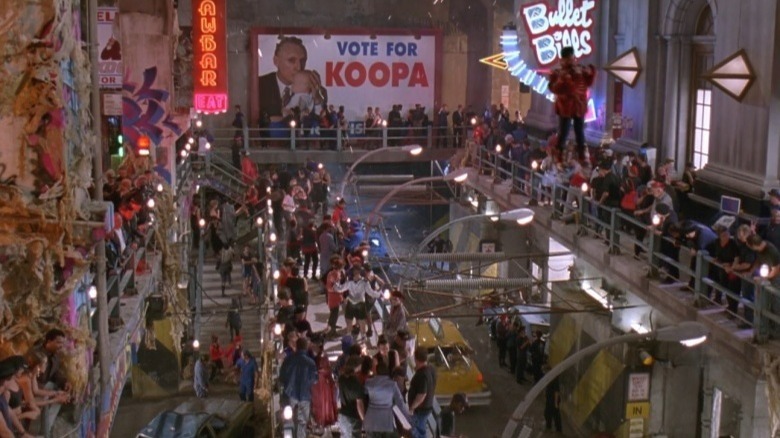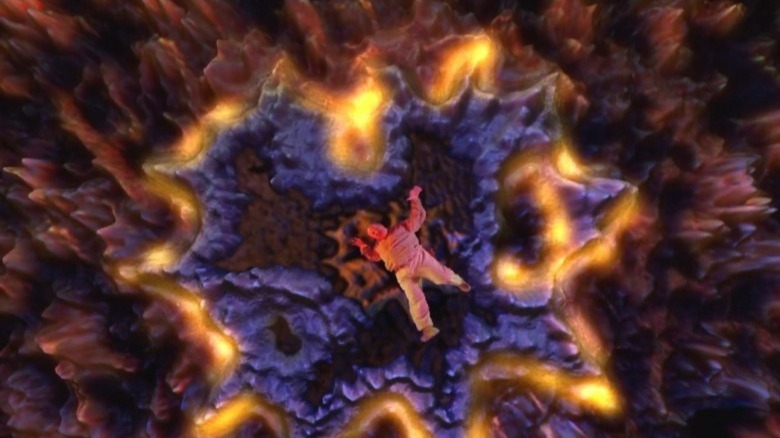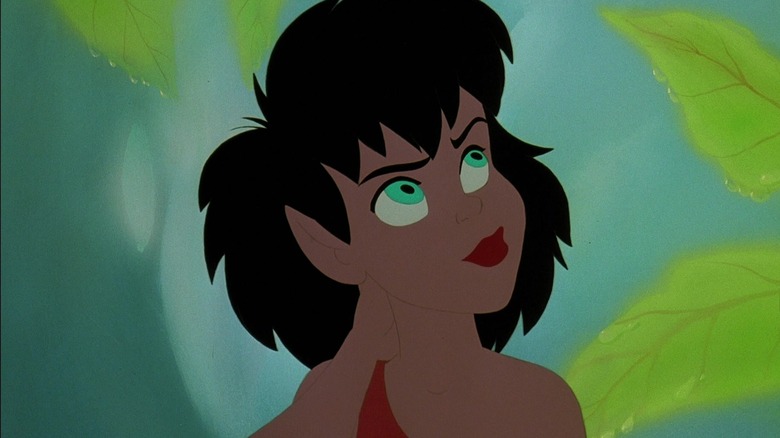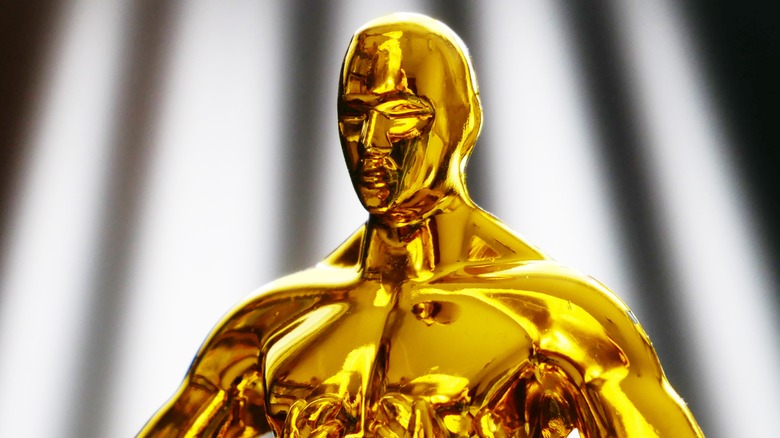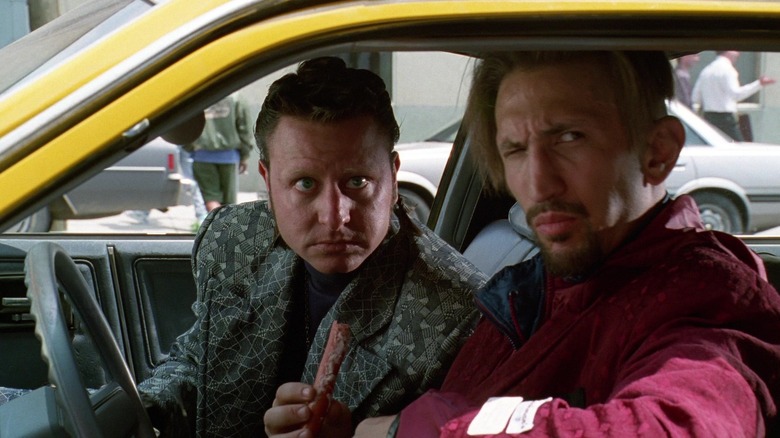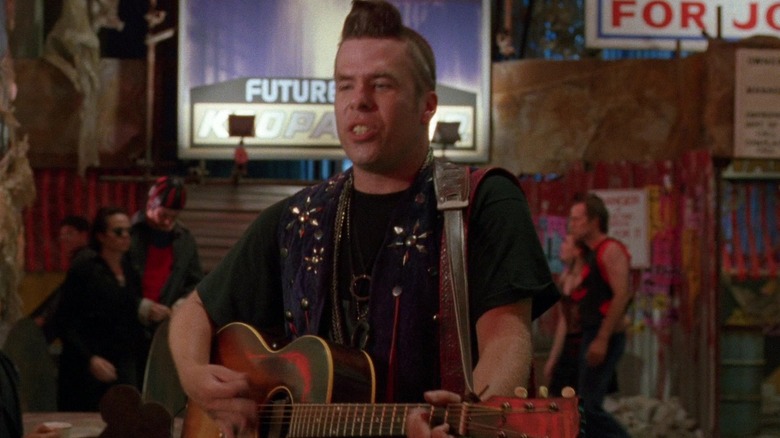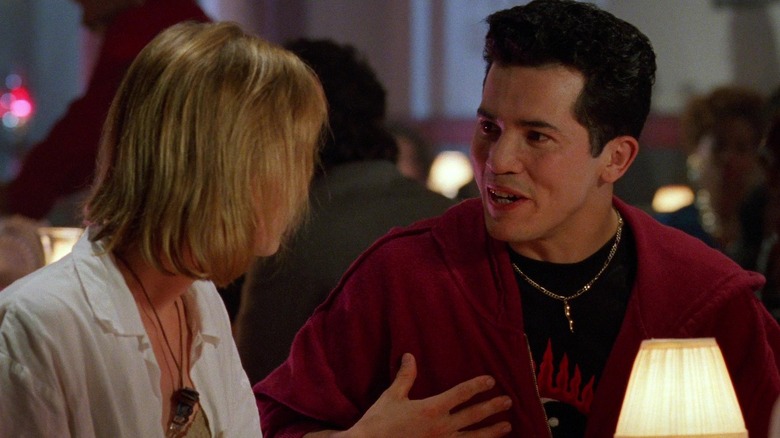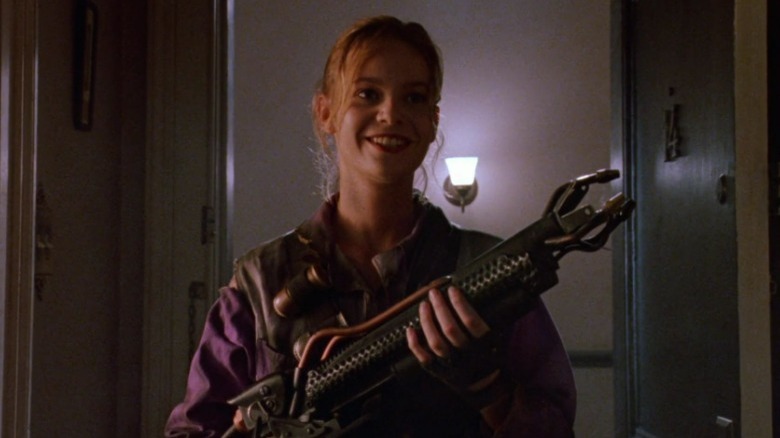Facts About 1993's Super Mario Bros. Movie Even King Koopa Can't Handle
No one could have imagined that a movie adaptation of what might be the most beloved video game franchise of all time would turn out to be an incomprehensible and strangely dark disaster on every level. "Super Mario Bros.," released in 1993, was the first video game to be adapted into a full-length live-action Hollywood feature film. Somehow, miraculously, it wasn't the last. It starred Bob Hoskins and John Leguizamo as Mario and Luigi, and was one of those rare movies where none of the stars aligned and all of the cylinders misfired. Drama, misfortune, incompetence, and just all around idiocy sullied every aspect of the production, from the script all the way to the editing room.
There's a lot of failure to cover, so let's get started revealing the untold truths of the "Super Mario Bros." movie.
It was written by a small army
Here's a dirty little Hollywood secret: If you're watching a movie made by a major Hollywood studio, there's a good chance it was either partially or completely rewritten multiple times by multiple writers. Even then, "Super Mario Bros." had a lot of writers by comparison. Around a dozen writers turned in drafts, with a number of writing teams being brought on and unceremoniously fired for not delivering on the vision whichever director the movie had that week had in mind.
Early scripts were more reminiscent of the games. They were colorful, bright, and featured many of the villains and allies Mario encountered throughout his side-scrolling adventures. Oh, and Koopa was a giant spiked lizard (as opposed to Dennis Hopper). They were at least a bit closer to the fairy tales they should have been. But when producers finally settled on a pair of directors, a husband and wife team named Annabell Jankel and Rocky Morton, creators of the iconic underground dystopian sci-fi character "Max Headroom," they brought along their own ideas for script revisions. Their ideas were mostly what you end up seeing in the movie that exists today, but the film's producers were so worried that they'd so radically moved the script from its source material that a new set of writers were brought in to fix it. The producers then barred the directors from even speaking to the new writers.
When the principal cast of the movie arrived on set and read the new version of the script for the first time they were furious. It wasn't at all the movie they had signed on for. This set the tone for the production to come.
The big name actors who almost played Mario
There's no denying that Bob Hoskins was one of the most Mario-looking actors around at the time. And considering that Mario isn't much of a character outside of a few catchphrases, Hoskins' portrayal of the overall-clad hero isn't too bad. But the role could have gone to a few different actors, all of whom are legends in their own right.
Two-time Oscar winner Dustin Hoffman wanted the role of Mario but Nintendo, which was more involved in the production early on than later when everything was a mess, didn't feel he was right for the role. So producers turned their sights to Danny Devito, but he also turned them down.
Then producers looked to the man who is now one of the biggest names in Hollywood history: Tom Hanks. At the time, Hanks was a rising star who charmed in every film lucky enough to cast him. Unfortunately for him (but ultimately very fortunately for him), he didn't get the part. His two most recent films, "The 'Burbs" and "Bonfire of the Vanities," were disappointing flops that scared off producers at the time. His star power had momentarily taken a hit but would soon recover and grow stronger than ever. In the years to come, he would win two Academy Awards and become one of the biggest stars in the world. It's probably for the best. If he had won the role of Mario, who knows what the effect could've been on his career to follow.
It was inspired by Blade Runner and Die Hard, not the video games
You might be wondering where all these screenwriters were taking their inspiration from, if it wasn't from Mario's bright video game world. That's a fair question with an answer that might infuriate you: big-budget, adult-oriented, R-rated, extremely violent action movies. Namely, "Die Hard," "Mad Max," and a little splash of "Blade Runner" thrown in, because why not?
In the late 1980s and early 1990s, those three films were the cultural touchstones everyone was referencing when it came to big-budget action and science fiction. The "Die Hard" inspiration was so extreme that one version of the script even called for a Bruce Willis cameo. The idea was for him to be crawling through the air vents above Koopa's office. Taking direct inspiration from the "Mad Max" series, another version of the screenplay had the characters driving tricked-out post-apocalyptic cars and participating in death races. It seems like nobody in charge of making a "Super Mario Bros." movie actually wanted to make a "Super Mario Bros." movie. The next point makes that abundantly clear.
Mario + Luigi - Overalls = Bad
The directors were brought in for their artistic vision. They had worked primarily on music videos and had some experience making a couple of dark, trippy feature films. When it came to the visual aspect of making a movie, they were legitimately innovative for their time. But their philosophies might have been a little too wild for "Super Mario Bros." Case in point: they didn't even want to dress Mario and Luigi in their classic red and green overalls.
The directors argued with the producers for most of the length of the production, with the producers demanding that Mario and Luigi look at least a little bit like the characters in the video games. Morton and Jankel fought them tooth and nail for about three-quarters of the production until they gave in. If not for the producers' dogged insistence, the only visually recognizable aspect of Mario and Luigi would be Bob Hoskins' mustache.
The directors were disliked by the cast and crew
Morton and Jankel must've had a really rough time making this movie. Not only was the movie bad and everybody on set knew it, but their primadonna attitudes and arrogance effectively ruined their film careers and any chance of making even a single friend onset. The cast and crew practically hated the directing duo, often resorting to calling them names behind their backs and grumbling about their bizarre and mean antics. After the production, Hoskins and Dennis Hopper had unkind things to say about their directors. Hoskins believed Morton and Jankel had no idea what they were doing. Dennis Hopper later complained that the two never communicated ideas or script changes to one another, leading to mass confusion onset.
Their reputations took the biggest hits when, according to John Leguizamo, Morton was looking over the extras. He thought one of them didn't look dirty enough, so he grabbed a cup of coffee and poured it over the extra's head. The extra reportedly screamed in pain as the hot coffee ran down his back and chest. Morton claims the coffee had been sitting around for a while, but then contradicts himself by saying that when the extra complained it was hot he doused the extra with cool water to soothe the pain.
John Leguizamo's on set drunk driving
Leguizamo and Hoskins were so over the production's tormented run that they started drinking scotch on set to pass the time and make the dark days go by a little easier. But as luck would have it, on one of the days they were kicking back shots they were called onto set to shoot a scene where they had to drive the Mario Bros. plumbing van. Leguizamo was reportedly feeling the effects of that day's boozing and was a little shaky behind the wheel. When the directors yelled "Action!" he slammed the accelerator, and then quickly slammed on the brake. The van's sliding door slammed shut on Hoskins' right hand. Hoskins had to wear a flesh-toned cast that can be seen at various points throughout the film.
The directors were banned from further participation
When production ended, the producers wanted to mitigate the financial losses they knew they were about to incur, so they spread the pain around by bringing in more producing partners. The now-massive team of producers decided the movie needed more action. Reshoots were scheduled. Remember earlier how Morton and Jankel were barred at one point from communicating with one of the many sets of screenwriters? A similar thing happened again. Twice.
The producers did not allow the directing duo to shoot even a single frame of the movie during reshoots. Their slow disassociation from the film reached its peak when they were also banned from the editing room. Morton claims the ban resulted from a disagreement between he, Jankel, and the producers over whether the film should be edited digitally, as is the modern day standard, or on old film editing machines called Moviolas. Though at that point, it sounds like they would've been barred anyway, regardless of whether it was edited on a computer or with magic.
Bob Hoskins really, really hated the experience
In August 2007, well over a decade after "Super Mario Bros." was released in theaters and universally panned by critics, Bob Hoskins gave an interview to The Guardian wherein he expressed his true feelings about his experience working on the film. To say he doesn't hold back is putting it mildly: "The worst thing I ever did? 'Super Mario Brothers.' It was a f***ing nightmare. The whole experience was a nightmare. It had a husband-and-wife team directing, whose arrogance had been mistaken for talent." Ouch.
Why Daisy sounds so familiar
When bringing Mario's world to life, the filmmakers made the unique choice to not include the iconic Princess Peach but instead Princess Daisy, first introduced in the video game "Super Mario Land." Daisy is played by Samantha Mathis, perhaps then best known for her playing Nora Diniro in the 1990 cult classic "Pump Up the Volume."
However, those with keen ears may recognize Mathis' voice from a project released just a year before "Super Mario Bros." — 1992's "FernGully: The Last Rainforest." Who does Mathis play in the animated cautionary tale about the environment? None other than the film's winged lead, Crysta, who fans will recall is the young fairy who stands up to toxic sludge monster Hexxus (Tim Curry) and falls in love with Walkman-loving logger Zak (Jonathan Ward).
It's pretty impressive for someone to play characters as iconic as Crysta and Daisy within a year of each other — even if the Princess Daisy of the "Super Mario" games is a little different than the version Mathis portrayed.
Super Mario Bros. almost got an Oscar nomination
Regardless of your stance on the "Super Mario Bros." film, you probably don't often hear it uttered in the same sentence as "Oscars" or "Academy Awards" very often. You may be surprised, therefore, to learn that the 1993 movie was indeed viewed as a viable candidate for the coveted statuette. As VFXblog reveals, "Super Mario Bros." was among those considered to receive a nomination for best visual effects at the following year's 66th Academy Awards given its extensive use of CGI and practical techniques for its more fantastical elements.
Ultimately, however, the competition was too much for "Super Mario Bros" to snag a nom, especially given the other dinosaur-themed movie that debuted in 1993 — "Jurassic Park." Still, it's in good company, as fan favorites like "Hocus Pocus" and "Addams Family Values" also didn't make the cut. A nomination, at least, would have been well-deserved, however, given that "Super Mario Bros." actually pioneered several new visual effects technology and software of the time — some of which, as "Super Mario Bros." animator Kevin Bjorke tells VFXblog, were developed specifically for the film.
Two actors who didn't stick to the script
Even though script rewrites were a practically daily occurrence on the "Super Mario Bros." set, the actors generally tended to stick with the lines they were given once they were finalized. Even Dennis Hopper, who once spent more than three hours verbally chastising directors Rocky Morton and Annabel Jankel over the constant dialogue changes, eventually chose to go along with what was written, as actor Richard Edson told The Guardian.
Ironically, however, Edson, who plays King Koopa's henchman Spike, is one of the only two actors who essentially threw the script out the window. The other, perhaps unsurprisingly, was Fisher Stevens, the actor portraying Spike's henchman partner-in-crime, Iggy. As Edson explains to The Super Mario Bros. The Movie Archive, his and Stevens' dissatisfaction with their original dialogue led to them pitching new material to Jankel and Morton, who were impressed enough to give the two actors almost complete control over their characters — including coming up with a rap that sadly ended up on the cutting room floor.
Toad's role was going to be much larger
Aside from Mario, Luigi, and Princess Peach, one of the most iconic heroic characters in the "Super Mario" franchise is the humanoid toadstool Toad, who's been with the gang since the game "Super Mario Bros. 2." Yet Toad's prominence doesn't do much to get him a major role in the '93 "Super Mario Bros." movie, where he's a musician who provides useful exposition to Mario and Luigi before being turned into a Goomba by King Koopa. Toad does appear a few more times, generally portrayed as kinder than his Goomba brethren, yet his role becomes much more peripheral from thereon out.
That wasn't always going to be the case, however. In multiple earlier versions of the script, Toad is a key ally once Mario and Luigi end up in King Koopa's world, either sticking with them throughout their entire adventure or popping in at key moments to lend the brothers a hand. On top of that, in the film's first screenplay draft, by Jim Jennewein and Tom S. Parker, Toad was originally going to look like "a 3-foot high TOADSTOOL SHAPED CREATURE" — basically his appearance in the video games, rather than a human with a unique haircut.
A later draft by Parker Bennett and Terry Runté would reinvent Toad as being part humanoid, part chameleon, which subsequent writers Dick Clement and Ian la Frenais initially stuck with before seemingly downplaying, if not removing, his lizard features in a later revision.
How the cast and crew warmed up to the film
Ask anyone who worked on the "Super Mario Bros." movie and they'll probably tell you it was a pretty rough experience. Their opinion of the film itself may not have always been so positive, either. Samantha Mathis, for instance, agrees with a lot of its critics, calling it "a pretty bad movie" on the Saturday Morning Rewind podcast.
Don't mistake that opinion for hate, however. As Mathis goes on to mention, there is definitely something she does appreciate about the movie, which is its strong affection from the people who love it. She's not alone, either — as John Leguizamo tells /Film, he's gained a greater affection for "Super Mario Bros." for the same reason and praises the trailblazing decision to cast a Colombian actor like himself in a leading role as Luigi. Another actor who's expressed a certain fondness for the movie is Fisher Stevens, aka Iggy, who told Entertainment Weekly, "I can't wait until my kids are old enough to watch this movie."
It's not just the actors who think there's something to "Super Mario Bros." after all, either. Visual effects designer and supervisor Chris Woods has praised the work he and his colleagues did for the film on VFXblog, while Allan Apone tells the Super Mario Bros. The Movie Archive that he and his production company MEL (short for Makeup & Effects Laboratory) "achieved everything and more that we set out to do."
The almost official sequel
For all the criticisms it gets, "Super Mario Bros." wraps most of its plot points up fairly conclusively. Just before the credits start to roll, however, viewers are hit with a whopper of a tease when Daisy shows up at the Mario brothers' apartment in full-on combat gear to recruit the siblings for another adventure.
After watching a scene like that, you could easily be forgiven for thinking there's a "Super Mario Bros." sequel out there. You'd actually be kind of right — just not in the way you might expect. Enter "Super Mario Bros. 2," a digital fan comic created by the owners of the Super Mario Bros. The Movie Archive website, Ryan Hoss and Steven Applebaum. In addition to Daisy and the brothers, characters like Toad and Daisy's father, King Reznor, appear in expanded roles, and a certain video game character makes his villainous debut. The comic also expands upon the powers Daisy gets from her dimension-bridging meteor fragment.
What sets this comic apart from other fan continuations is that it has input from Parker Bennett, who penned the film's second draft and the scene in the movie where Daisy comes back, as Bennett himself notes in the comic's intro. Though the original comic, featuring art and colors by Eryk Donovan, colors by Brett Michael Cook, and lettering by Jaymes Reed, remains unfinished, a reworked version debuted in 2021, this time with artwork by Carl Chrappa and seemingly swapping Wart out with Dinohattan police chief Sergeant Simon, one of King Koopa's former associates.
